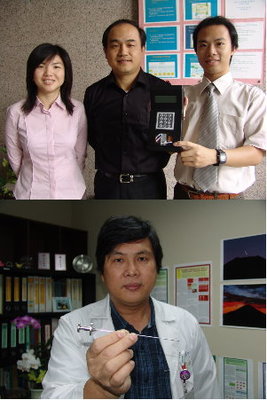Two Winners of National Innovation Award from NCKU

Two research teams of National Cheng Kung University (NCKU), led by Professor of Gwo-Bin Lee (李國賓) from Department of Engineering Science and Professor Yu-Chung Chang (張玉川) from Department of Surgery, are among 12 winners of the 2008 National Innovation Award (國家新創獎) sponsored by the Executive Yuan. Their awarded innovative works are “An integrated magnetic bead-based microfluidic system for rapid genomic DNA extraction and genetic diseases” (by Prof. Lee’s group) and “Chang’s Needle for Simplified Hepatic Resection detection” (by Prof. Chang’s group), respectively. The award will be presented in the convocation ceremony in Taipei around middle December.
Professor Lee’s research team presents a new magnetic-bead-based microfluidic platform integrating several moduli, including a human WBC (white blood cells) pretreatment module, a DNA extraction module and a nucleic acid amplification module for fast detection of genetic diseases by utilizing MEMS (micro-electro-mechanical-systems) technologies. The device can save more time but still with good accuracy on pre-treatment and diagnosis of the genetic diseases, compared with the conventional one. The plastic material used as the platform of the device is cost-effective and designed for portable use for medical examination. Prof. Lee’s research group includes doctoral students, Kang-Yi, Lien (連剛逸) and Zong-Min Xie (謝宗閔), and an assistant Quian-Ru Liu (劉倩如).
Professor Chang’s innovative needle is designed to facilitate hepatic resections. Chang’s needle consists of a straight annular needle with a hook near its tip to catch the thread and a 15 cm-long 18-gauge stainless steel sheath. Chang’s maneuver tries to simplify the technique of hepatic resection in order to reduce bleeding, to shorten the training time, and to enable a general surgeon, not a specialist of liver surgery, performing hepatic resections. Chang’s needle is cheaper, simpler, more compact, non-disposable, and easier to use. Therefore, more patients in the whole world can be benefited from this creative invention.
The advantages of this maneuver can be summarized as follows; 1) the use of cheap, simple, and reusable instrument; 2) no need for the use of Rummel tape in Pringle’s maneuver;3) shortened operation time; 4) reduction or avoidance of blood transfusion in most cases; 5) no need for haemostatic fibrin glue; 6) fewer ischemic and reperfusion injury of the remnant liver, thus simpler postoperative care; 7) lower level of stress to the surgeon during parenchyma transection due to lack of bleeding; 8) shortened training time for surgeons, and 9) an easier maneuver that allows more surgeons to perform hepatic resections.
Since September 1997, 92 cases of hepatic resections have been performed without procedure-related mortality or morbidity through Chang’s maneuver, which was awarded with patents in Taiwan, US, Korea and China.
Professor Lee’s research team presents a new magnetic-bead-based microfluidic platform integrating several moduli, including a human WBC (white blood cells) pretreatment module, a DNA extraction module and a nucleic acid amplification module for fast detection of genetic diseases by utilizing MEMS (micro-electro-mechanical-systems) technologies. The device can save more time but still with good accuracy on pre-treatment and diagnosis of the genetic diseases, compared with the conventional one. The plastic material used as the platform of the device is cost-effective and designed for portable use for medical examination. Prof. Lee’s research group includes doctoral students, Kang-Yi, Lien (連剛逸) and Zong-Min Xie (謝宗閔), and an assistant Quian-Ru Liu (劉倩如).
Professor Chang’s innovative needle is designed to facilitate hepatic resections. Chang’s needle consists of a straight annular needle with a hook near its tip to catch the thread and a 15 cm-long 18-gauge stainless steel sheath. Chang’s maneuver tries to simplify the technique of hepatic resection in order to reduce bleeding, to shorten the training time, and to enable a general surgeon, not a specialist of liver surgery, performing hepatic resections. Chang’s needle is cheaper, simpler, more compact, non-disposable, and easier to use. Therefore, more patients in the whole world can be benefited from this creative invention.
The advantages of this maneuver can be summarized as follows; 1) the use of cheap, simple, and reusable instrument; 2) no need for the use of Rummel tape in Pringle’s maneuver;3) shortened operation time; 4) reduction or avoidance of blood transfusion in most cases; 5) no need for haemostatic fibrin glue; 6) fewer ischemic and reperfusion injury of the remnant liver, thus simpler postoperative care; 7) lower level of stress to the surgeon during parenchyma transection due to lack of bleeding; 8) shortened training time for surgeons, and 9) an easier maneuver that allows more surgeons to perform hepatic resections.
Since September 1997, 92 cases of hepatic resections have been performed without procedure-related mortality or morbidity through Chang’s maneuver, which was awarded with patents in Taiwan, US, Korea and China.
Provider:
新聞中心
Date:
2008-11-25